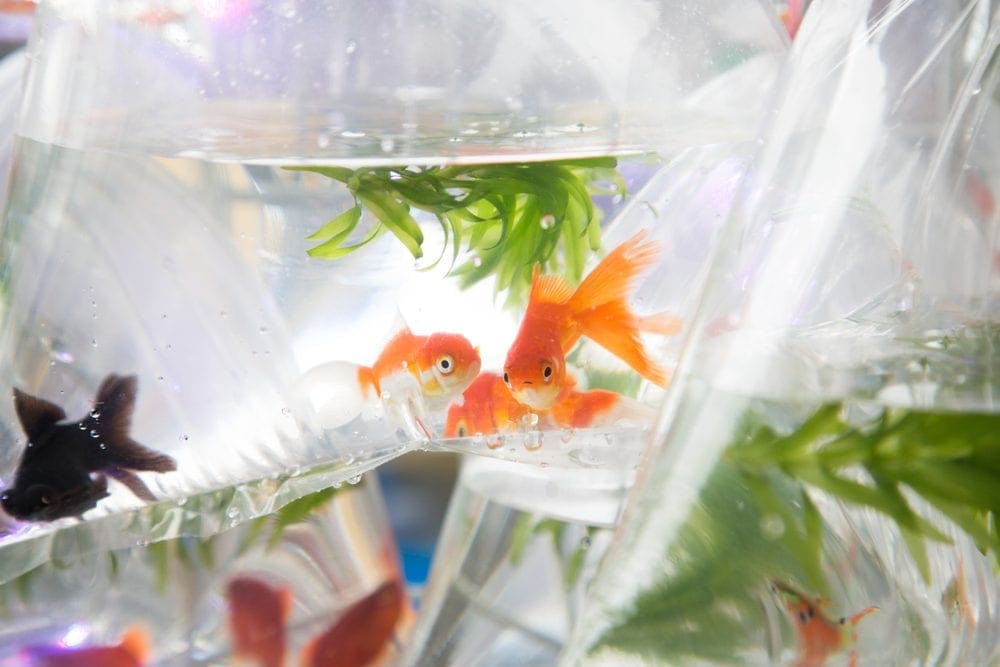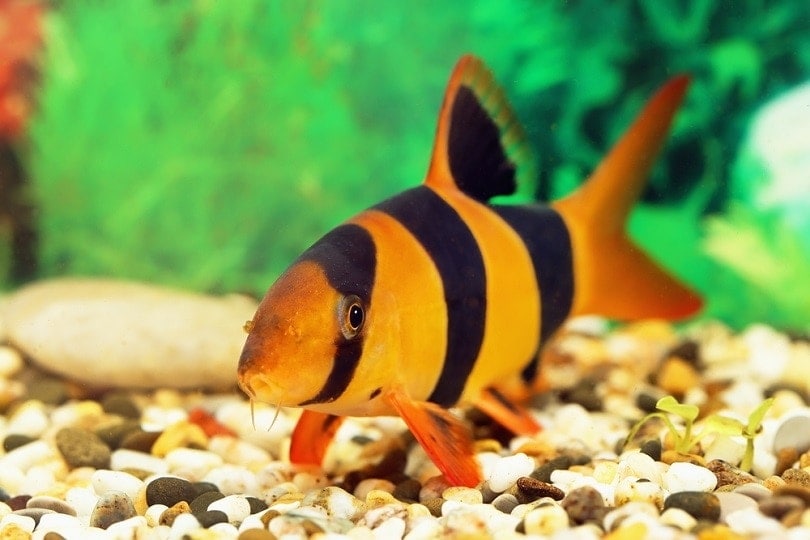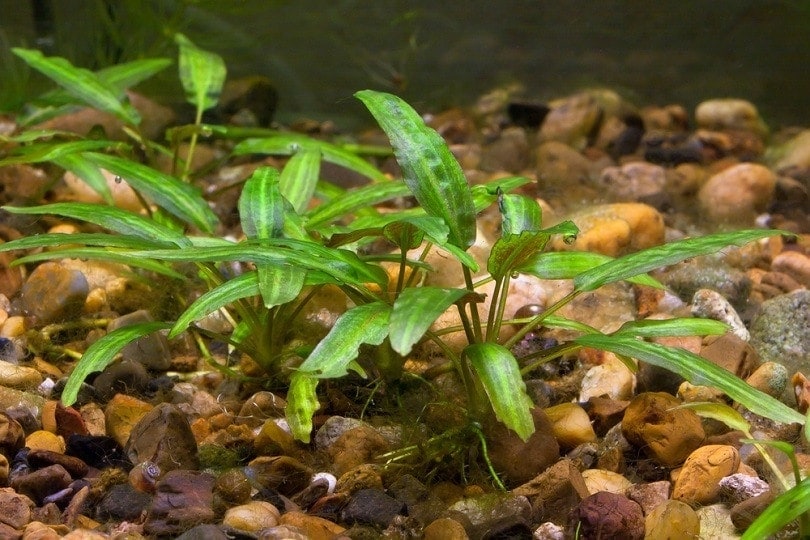Harlequin Rasbora: Vet-Approved Care, Pictures, Food, Lifespan & Tank Setup Tips

Updated on
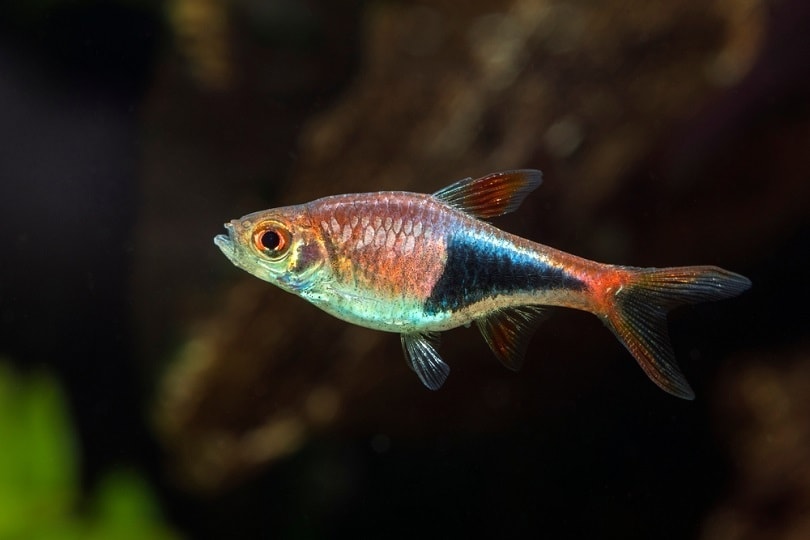
Harlequin rasboras (Trigonostigma heteromorpha) is an excellent shoaling fish suited to community tanks. They are attractive fish that grow to about 2 inches (5 centimeters) in length, but they also add vivid colors to the center of your tank. They make great fish for beginners and their care is straightforward. Harlequin rasboras are not as demanding as other types of shoaling fish and are a great pleasure to have in your tank. Their simplistic care needs to match the criteria of a perfect novice aquarist fish.
Aside from their beauty, harlequin rasboras also have eccentric personalities. They are generally friendly with other fish and enjoy swimming in large groups of their species. This guide will provide you with in-depth care and information to keep a healthy shoal of harlequin rasboras.
Quick Facts About Harlequin Rasboras
| Species Name: | Trigonostigma heteromorpha |
| Family: | Cyprinidae |
| Care Level: | Beginner-friendly |
| Temperature: | 71.6 – 77 °F (22 – 25°C) |
| Temperament: | Peaceful, shoaling |
| Color Form: | Orange caudal peduncle (base of tail), black triangular patch on a silver body |
| Lifespan: | 5 years (estimate) |
| Size: | 2 inches (5 centimeters) |
| Diet: | Omnivores |
| Minimum Tank Size: | 15 gallons for a shoal of 6 |
| Tank Set-Up: | Freshwater, planted, tropical conditions |
| Compatibility: | Community (peaceful) or species-only tanks |
Harlequin Rasbora Overview
The harlequin rasbora originates from the tropical waters in Asia and can be found in Malaysia, Singapore, and Thailand. They are part of the Cyprinidae fish family and live between 3 – 5 years on average. They are commonly referred to as harlequins and inhabit blackwater habitats like swamps, rivers, and streams found in South East Asia. Harlequins are suitable for all levels of aquarists. Both novice and seasoned aquarists find joy in keeping these fish. They are easy to set up for and their care is straightforward.
Harlequins are a great fish for beginners who are starting their first tropical community aquarium. They add vivid colors to your aquascape and will be seen swimming in the midwaters of the tank. They require a large group to remain happy and portray shoaling behavior. For this reason, we recommend at least 6 or more harlequins to be kept in a tank. They do well with a variety of other peaceful fish and rarely display aggressive behavior unless they are in a small shoal.
These fish are fairly sought out in the aquarium hobby and new owners seek out their small size and beautiful colorations. They only grow to a maximum size of 2 inches, making them perfect for tanks around 15 gallons in size. They appreciate a variety of live plants in their freshwater tank and do best when kept with a heater.
Harlequins can tolerate a variety of water temperatures from 22 – 25°C (71.6 – 77 °F). It is recommended to only place them in tropical tanks regardless of their tolerance for slightly lower temperatures.
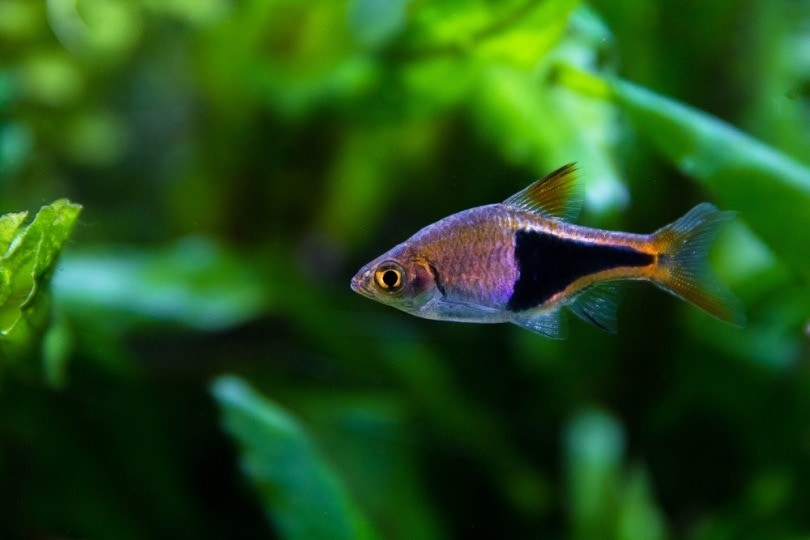
How Much Do Harlequin Rasboras Cost?
You should be able to find a healthy stock of harlequins at your local pet store. They are widely available and nearly every pet store stocks them. They can also be found from breeders online who may offer a larger variety of colors the fish can come in. You should not expect to pay more than $2 to $4 for a harlequin. Since you will need to purchase at least six at a time, you can expect to pay $12 for a small shoal.
It is highly recommended to purchase harlequins from the same tank in the pet store instead of buying them one by one from different stores. This allows them to have already established a connection with their current tank mates and form a stress-free shoal easily.
Typical Behavior & Temperament
Harlequins are timid and peaceful fish who will not pose any aggressiveness towards other tank mates. Their peaceful nature makes them suitable for community tanks with other smaller fish. They easily become stressed if they do not have a large shoal of their species. They naturally shoal in the wild and this makes them feel protected amongst each other. Placing them in a tank with no shoaling possibilities will increase their risk of disease and they will display stressed behaviors.
A group of 10 is a great number of harlequins to stock your tropical tank with. They rarely fin-nip unless their tank or shoal is too small, in which case, they may show aggression to their species and nip at other slow-moving fish. Chasing is also a common sign of stress if you are keeping too few harlequins in the tank. Allowing these fish to exhibit their natural behaviors is the best way to get them to behave with other fish.
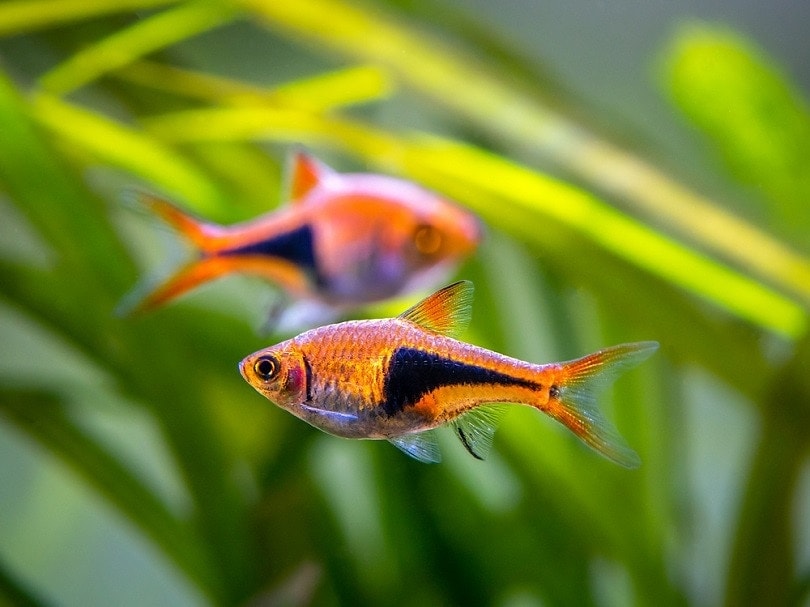
Appearance & Varieties
Their small size allows them to comfortably fit into small tanks. They grow between 1.5 to 2 inches on average. This small size allows them to be flexible when it comes to tank sizes and they are known to be content in nano set-ups.
They have a lengthy mid-section that narrows towards the mouth. They have a forked caudal fin and a black patch that forms narrowly along the body and stops as it reaches the caudal fin. Their name is derived from the appearance of the black patches that match the clown famously known as Harlequin. This pattern is striking to the eye and is what catches the attention of nearly all rasbora owners.
To further resemble the classic clown patterns, they have a silver body and orange tinges covering their body. The fins can range from an intensity of dark to light orange and are affected by environmental conditions and stress. A stressed harlequin will have transparent dull orange fins that will gradually darken as they start to get more comfortable. If you want to preserve the appearance of your harlequin fish, your best option is to ensure that you provide the right conditions and diet for them. This allows you to experience their most vibrant colors.
How to Take Care of Harlequin Rasboras
Habitat, Tank Conditions & Setup
Tank/aquarium size
The small body of a harlequin rasbora allows you to keep them in a wide variety of tank sizes. Although these fish are small, as for all fish they should not be kept in bowls, vases, or any spherical-shaped aquarium. This is due to the lack of space and the fish must endure in such setups. We recommend keeping a group of six harlequins in a minimum of 15 gallons. The tank should be a standard rectangular size with more length than width.
Tall tanks are unnecessary for these fish and do not allow them to form a proper shoal formation. They enjoy swimming with a calm current and this is what they are adapted to do in the wild. If you plan to add more, we recommend a rough guide of 2 gallons per additional harlequin. A group of 10 harlequins can successfully be kept in a 25-gallon tank. Keep in mind if you have other fish in the tank, the size should be increased to accommodate the entire community.
Water temperature and pH
These fish are strictly tropical. They prefer living in warm waters provided by a quality aquarium heater. They need a temperature range between 22 – 25°C (71.6 – 77 °F). We recommended presetting the heater to 24°C (75 °F) to avoid any major fluctuations in temperature. This also seems to be a temperature they do well at during all seasons of the year. Harlequins require a pH between 6.0 to 8.0, though they are best at 7.0 (which is also a generally acceptable value for most of their compatible community mates).
Substrate
Fine gravel and aquarium sand is ideal for the bottom of a harlequins tank. A 1-inch layer is perfect to provide a breeding ground for beneficial bacteria. The deep substrate also allows you to grow live plants. If you plan to go deeper with sand substrate, it’s best to consider burrowing snails as tank mates so that they may constantly filter the sand to prevent the growth of anaerobic bacteria.
Plants
Live plants are beneficial to a harlequin’s environment. They provide a means of filtration, shelter, and at times, a food source. Plants also accentuate the tank and bring out the harlequin’s vivid colors. A dash of greenery in the tank allows for an easier view of your shoal. That being said, live plants can be daunting for a beginner, and harlequins can also be placed in a tank with aquarium-safe silk plants.
Lighting
Harlequins are not overly fussy with their lighting requirements. They can tolerate moderate lighting conditions. They can have both natural and artificial lights. Lights help to bring out their colors and make it easier for you to view in your aquarium. Avoid keeping the lights on for more than 8 hours a day if there are no live plants in the aquarium. If you decide to use artificial lights, the ones with a timer for a day and night cycle are recommended.
Filtration
Filtration is important for a harlequins tank. This will keep the water clean, provide aeration and provide a lush current. As a general rule, depending on your tank’s stocking levels, the filter should be able to take in two to five times the amount of water volume in an hour.

Are Harlequin Rasboras Good Tank Mates?
Yes, these fish make great tank mates. They have a very peaceful temperament that allows them to ignore other fish in the tank and focus on swimming in their shoal. Aside from keeping a group of harlequins, there is also a variety of other small and peaceful fish you can house with them. They make excellent community tank fish and do their best when kept with fish that swim at different levels.
Since most aquarists keep these fish in nano tanks, it is unsuitable to keep other shoaling fish who will get in the harlequin’s way. The tank mates should not be large enough for your harlequin to fit inside. They should also not be prone to fin-nipping or chasing. Other non-finned creatures can be kept with these fish, this includes aquarium snails or shrimp. Ensure you only choose tank mates that live in similar conditions to your harlequin.
- Mystery snails
- Neon tetras
- Cory catfish
- Honey gourami
- Danios
- Cherry barbs
- Rummy nose tetra
- Freshwater “sharks” (such as the rainbow shark or red-tailed black shark)
- Any cichlids (such as convicts or oscars)
- Jack Dempsey
- Goldfish
What to Feed Your Harlequin Rasbora
These fish are not fussy when it comes to feeding time and will gladly accept a range of foods from you. They have established omnivores and should be fed foods that are rich in both vegetation and meat-based protein. Foods like daphnia, mosquito larvae, bloodworms, brine shrimp and algae wafers can be used for supplementation purposes.
A good quality commercial pellet, granule, or flake should be fed as the main diet. You can split the feeding amount to two portions a day for juvenile harlequins and once a day for adults. Supplements can be fed around three times a week (as a general guideline ).
Keeping Your Harlequin Rasbora Healthy
Harlequins are easy to keep healthy. They are hardy enough to withstand many novice aquarists’ mistakes. These fish are not very demanding and can be kept healthy by following a few steps.
- You should always ensure that you house your harlequins in an appropriately sized tank with a good filter. They can easily become stressed when their conditions are incorrect which will encourage sickness and disease.
- The water should also be tested regularly to see how much ammonia, nitrites, and nitrates are in the water.
- The water should be changed at least once a week in small percentages (around 20 – 25%) to keep the parameters within a good range.
- They should have a large group to form a shoal. This is one of the most important requirements to keep a harlequin healthy.
- Seek aquatic veterinary care if you suspect that your harlequin rasboras are unwell.
If you meet all their requirements, you can expect them to live around 5 years or so. Poor care will result in a shortened lifespan.
Breeding
Breeding harlequins is a hard task. They are not easy to breed as pets and expert aquarists are only able to breed them. This, however, does not mean it’s impossible to achieve a successful breeding opportunity if you are a beginner or intermediate. It is important to ensure that their conditions are kept like the conditions they will encounter in the wild when it is breeding season. They require warm temperatures to breed, around 28°C. This will help stimulate the water temperature in the wild and encourage spawning. They also require soft, acidic water to spawn.
It is also important to first feed protein-rich foods like daphnia. Unlike most rasboras, harlequins do not scatter their eggs and require surfaces, such as leaves, on which to stick their eggs to. When the female is ready to spawn, she will rub her belly on the underside of the broadleaf, this will signal to the willing male to fertilize the eggs. The parents should be removed from the breeding tank after spawning because they will start to eat the eggs. Fry should hatch within 18 hours at ideal temperatures.
Conclusion
Harlequin rasboras will do well in most tanks. A suitably sized tank, plants, filtration, and a large shoal are necessary to keep these fish thriving. This description fits many standard tank setups which makes them suitable for a wide variety of tanks. Relatively little effort is needed to prepare a suitable harlequin rasbora tank and they may fit in with your already established tropical tank. If arrangements are taken to provide them with their appropriate requirements, harlequins will make a delightful shoaling fish for your tropical tank.
We hope this article has increased your understanding of these fascinating fish!
Featured Photo Credit: InsectWorld, Shutterstock





